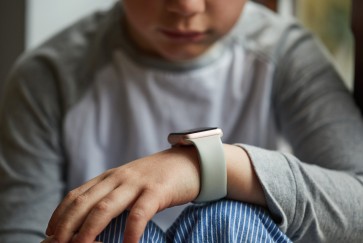Last summer, Northwestern University researchers introduced the first-ever transient pacemaker — a fully implantable, wireless device that harmlessly dissolves in the body after it’s no longer needed. Now, they unveil a new, smart version that is integrated into a coordinated network of soft, flexible, wireless, wearable sensors and control units placed around the upper body.
The study will be published Friday (May 27) in the journal Science. The work was led by Northwestern’s John A. Rogers, Igor R. Efimov and Rishi Arora.
The sensors communicate with each other to continuously monitor the body’s various physiological functions, including body temperature, oxygen levels, respiration, muscle tone, physical activity and the heart’s electrical activity.
The system then uses algorithms to analyze this combined activity in order to autonomously detect abnormal cardiac rhythms and decide when to pace the heart and at what rate. All this information is streamed to a smartphone or tablet, so physicians can remotely monitor their patients.
The new transient pacemaker and sensor/control network can be used in patients who need temporary pacing after cardiac surgery or are waiting for a permanent pacemaker. The pacemaker wirelessly harvests energy from a node within the network — a small wireless device that softly adheres to the patient’s chest. This technology eliminates the need for external hardware, including wires (or leads).
To enable the system to communicate with the patient, the researchers incorporated a small, wearable haptic-feedback device that can be worn anywhere on the body. When the sensors detect an issue (such as low battery power, incorrect device placement or pacemaker malfunction), the haptic device vibrates in specific patterns that alert wearers and inform them of the problem.
Insights from the experts
“This marks the first time we have paired soft, wearable electronics with transient electronic platforms,” Rogers said. “This approach could change the way patients receive care providing multimodal, closed-loop control over essential physiological processes — through a wireless network of sensors and stimulators that operates in a manner inspired by the complex, biological feedback loops that control behaviors in living organisms.
The system untethers patients from monitoring and stimulation apparatuses that keep them confined to a hospital setting. Instead, patients could recover in the comfort of their own homes.”
Biomedical engineer
“For temporary cardiac pacing, the system untethers patients from monitoring and stimulation apparatuses that keep them confined to a hospital setting. Instead, patients could recover in the comfort of their own homes while maintaining the peace of mind that comes with being remotely monitored by their physicians. This also would reduce the cost of health care and free up hospital beds for other patients.”
“In current settings, temporary pacemakers require a wire that is connected to an external generator that stimulates the heart,” Efimov said. “When the heart regains its ability to stimulate itself appropriately, the wire has to be pulled out. As you might imagine, this is a pretty dramatic procedure to pull out a wire connected to the heart. We decided to approach this problem from a different angle. We created a pacemaker that simply dissolves and does not need to be removed. This avoids the dangerous step of pulling out the wire.”
“Current pacemakers are quite intelligent and respond well to the changing needs of the patients,” Arora said. “But the wearable modules do everything traditional pacemakers do and more. A patient basically wears a little patch on their chest and gets real-time feedback to control the pacemaker. Not only is the pacemaker itself bioresorbable, it is controlled by a soft, wearable patch that allows the pacemaker to respond to the usual activities of life without needing implantable sensors.”
Rogers is the Louis Simpson and Kimberly Querrey Professor of Materials Science and Engineering, Biomedical Engineering and Neurological Surgery at Northwestern’s McCormick School of Engineering and Northwestern University Feinberg School of Medicine and the director of the Querrey Simpson Institute for Bioelectronics (QSIB). Efimov is a professor of biomedical engineering in McCormick and professor of medicine (cardiology) in Feinberg. Arora is a professor of medicine at Feinberg and co-director of the Center for Arrhythmia Research.
Connecting the ‘body-area network’
A bioelectronics pioneer, Rogers and his lab have been developing soft, flexible, wireless wearable devices and bioresorbable electronic technologies for nearly two decades. In the new study, Rogers and his collaborators combined and coordinated their bioresorbable, leadless pacemaker with four different skin-interfaced devices to work together. The skin-mounted devices are soft, flexible and can be gently peeled off after use, eliminating the need for surgical removal. The pacemaker naturally dissolves in the body after a period of need.


